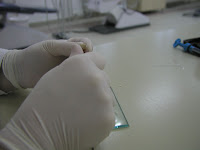Glass-ionomer cements (GIs) are still the only true self-adhesive materials forming the chemical bond with tooth tissues. Despite the traditional classification to types of GIs, current scientific literature is dominated by a simpler and yet more informative classification to conventional and resin-modified GIs. This indicates information about materials' chemical composition, curing mode and clinical application steps.
The difference between conventional and resin-modified GIs is in the organic resin monomers added to the latter formula which enables prompt light-curing of the material using halogen or LED units. Light curing of resin creates favourable micro-environment for the conventional acid-base reaction between polyacrilic acid and glass particles. Improvements in material composition have led to improved mechanical properties although GIs are still inferior compared to resin-based composites. On the other hand, sensitivity to water imbalance, characteristic for early GIs, has been largely overcome in modern GIs both conventional and resin-modified. More information about GIs, their composition, properties and indications may be found in an excellent review article by Hewlett and Mount, published in 2003.
[Full text]
One of the indications for GIs is the so-called "sandwich" technique with composite materials for large restorations on both vital and endodontically treated teeth. According to manufacturers' instructions both conventional and resin-modified GIs may be used for this purpose. Though it is widely known that early GIs were sensitive to water imbalance during setting, there is a certain controversy regarding this issue with current GIs. Due to this controversy, a clinical dilemma exists among dental practitioners when using GIs in combination with total-etch adhesives prior to composite placement. This dilemma is not about the acid but rather water rinsing afterwards. Simply, some practitioners are not convinced that GIs should be exposed to water so early after the setting (e.g. 3 minutes for FUJI IX GP Fast) or immediately after light curing of resin-modified GIs.
The manufacturer recommends the following protocol (Figure 1):
 |
| Figure 1. GC Europe recommends enamel etching after the placement of GI intermediary layer. (1) Old amalgam restoration; (2) Cavity preparation; (3) Conditioning; (4) Application of GI ; (5) GI layer ready; (6) Enamel etching; (7) Application of adhesive; (8) Light curing and (9)-(12) Placement of composite. |
An alternative protocol suggested by some dental practitioners (Figure 2):
 |
| Figure 2. Enamel etching prior to the placement of GI. From left to right upper row: Cavity preparation; Conditioning; Enamel etching. From left to right bottom row: Application of GI; Application of adhesive; Final composite restoration. |
|
|
|
The second approach does eliminate the possible adverse effect of water during acid rinsing. However, acid etching and rinsing prior to GI placement bears an inherent weakness - this approach requires impeccable precision. Dentin should not be etched if GI is to be placed since the mineral component required for chemical bonding will be lost. On the other hand, if adhesive is to be placed on dentin as well as on enamel, dentin should also be etched for proper micro-mechanical bonding of adhesive resin.
If one does not want to follow manufacturer's instructions and acid etch after the placement of the GI layer, then they should consider the use of self-etch adhesives instead of total-etch systems. One-step self-etch adhesives have shown inferior results regarding bond strength to dentin and enamel, degree of conversion, thickness of the hybrid layer, the quality of resin tags etc. On the other hand, current 2-step self-etch adhesives have shown satisfactory clinical and laboratory properties in a number of studies and are recommended as an alternative to total-etch adhesive systems.
In my practice, I always follow manufacturer's recommendations. In this case, I use resin-modified GIs for the "sandwich" technique and acid etch enamel after light curing of the GI intermediary layer.


















